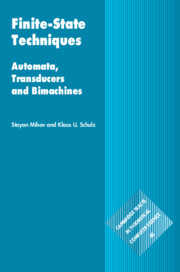Book contents
- Frontmatter
- Contents
- Preface
- Part I Formal Background
- 1 Formal Preliminaries
- 2 Monoidal Finite-State Automata
- 3 Classical Finite-State Automata and Regular Languages
- 4 Monoidal Multi-Tape Automata and Finite-State Transducers
- 5 Deterministic Transducers
- 6 Bimachines
- Part II From Theory to Practice
- References
- Index
3 - Classical Finite-State Automata and Regular Languages
from Part I - Formal Background
Published online by Cambridge University Press: 29 July 2019
- Frontmatter
- Contents
- Preface
- Part I Formal Background
- 1 Formal Preliminaries
- 2 Monoidal Finite-State Automata
- 3 Classical Finite-State Automata and Regular Languages
- 4 Monoidal Multi-Tape Automata and Finite-State Transducers
- 5 Deterministic Transducers
- 6 Bimachines
- Part II From Theory to Practice
- References
- Index
Summary
Classical finite-state automata represent the most important class of monoidal finite-state automata. Since the underlying monoid is free, this class of automaton has several interesting specific features. We show that each classical finite-state automaton can be converted to an equivalent classical finite-state automaton where the transition relation is a function. This form of ‘deterministic’ automaton offers a very efficient recognition mechanism since each input word is consumed on at most one path. The fact that each classical finite-state automaton can be converted to a deterministic automaton can be used to show that the class of languages that can be recognized by a classical finite-state automaton is closed under intersections, complements, and set differences. The characterization of regular languages and deterministic finite-state automata in terms of the ‘Myhill–Nerode equivalence relation’ to be introduced in the chapter offers an algebraic view on these notions and leads to the concept of minimal deterministic automata.
Keywords
Information
- Type
- Chapter
- Information
- Finite-State TechniquesAutomata, Transducers and Bimachines, pp. 43 - 71Publisher: Cambridge University PressPrint publication year: 2019
